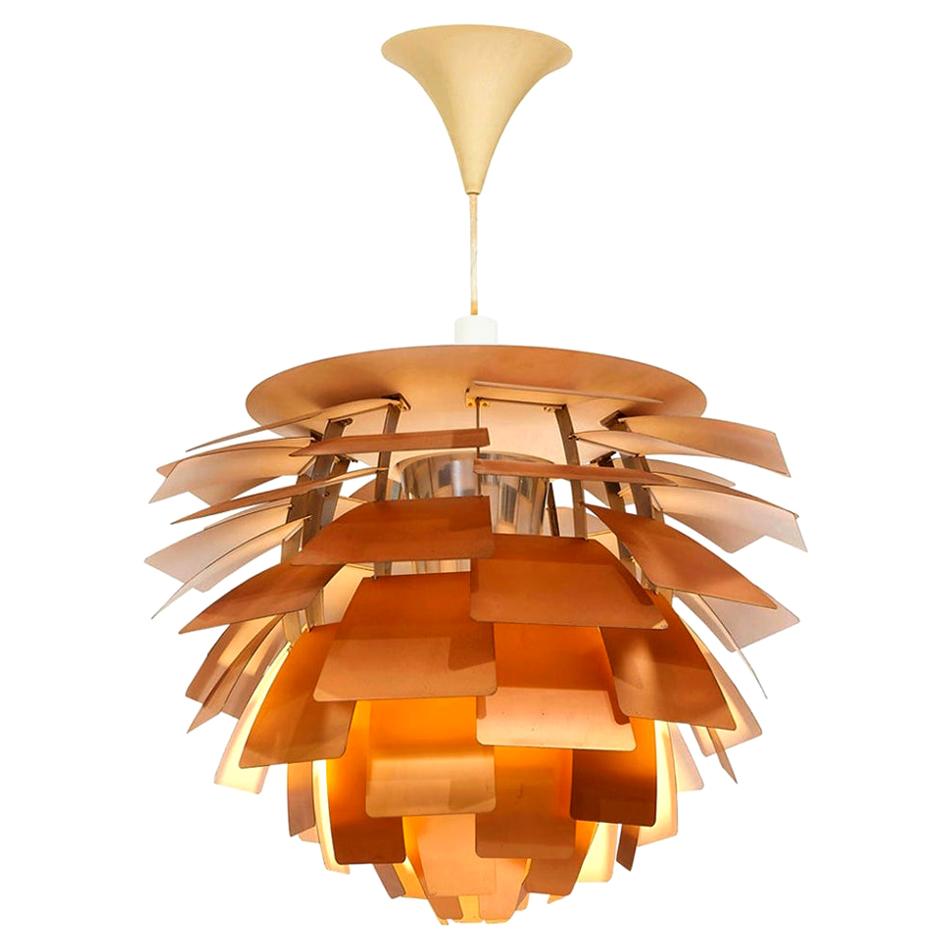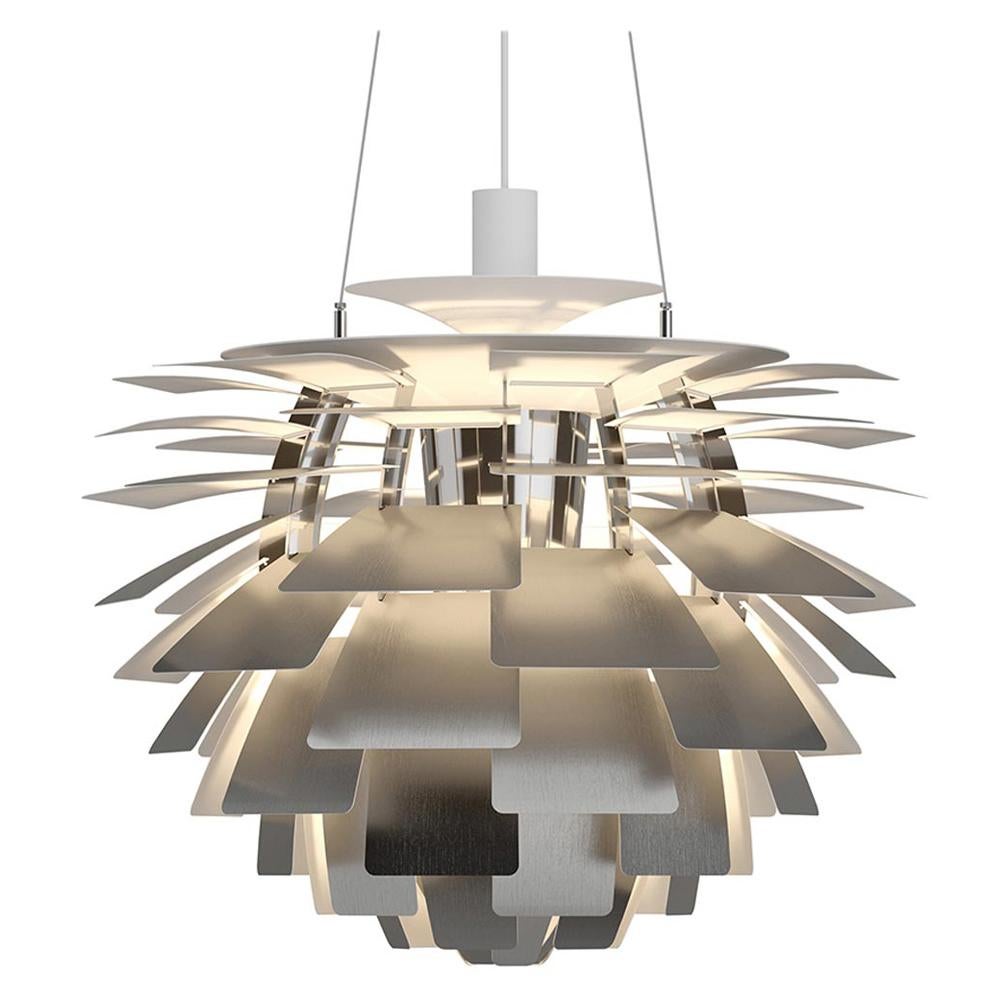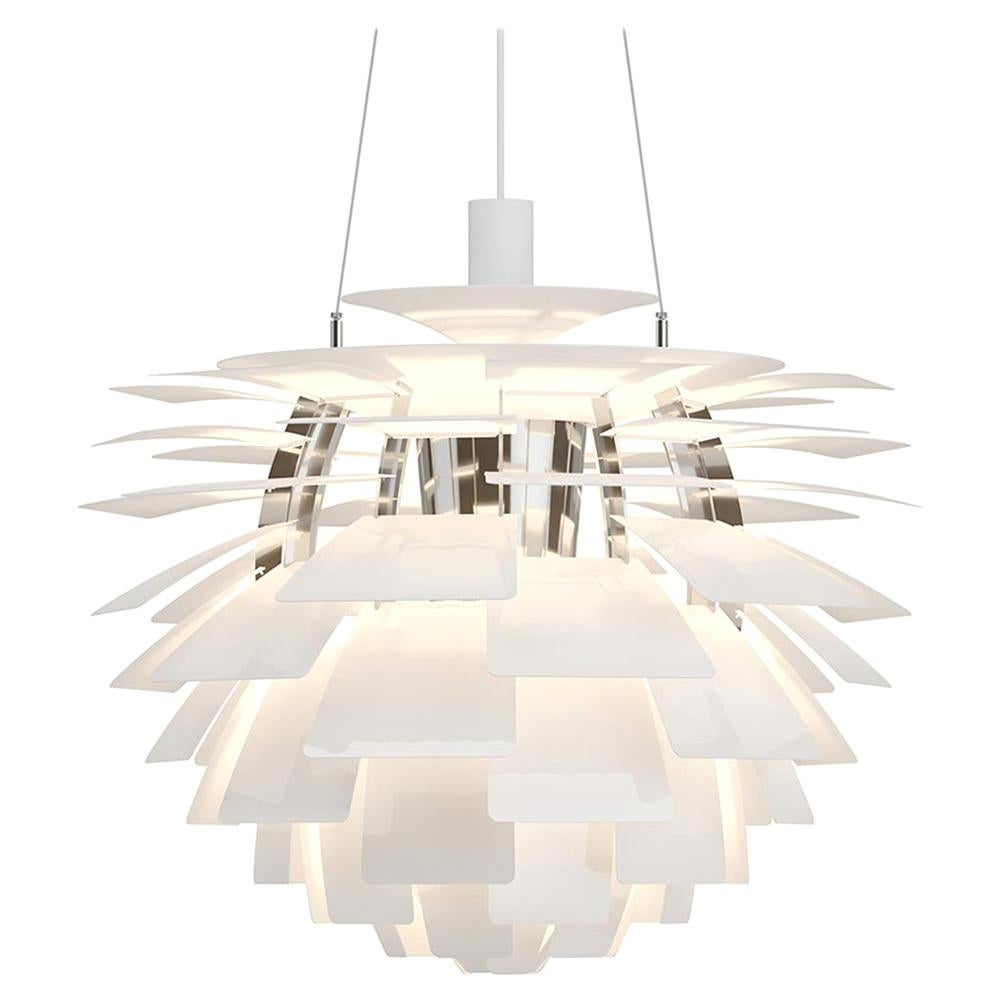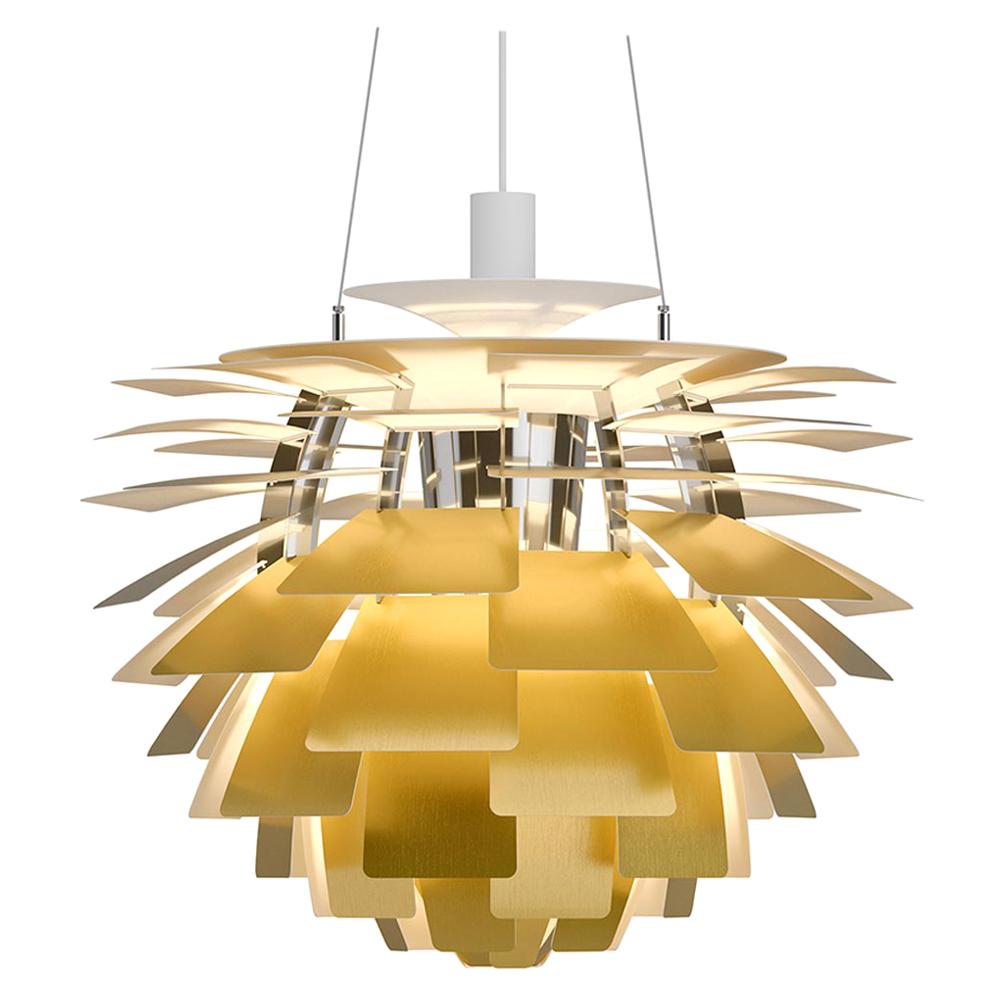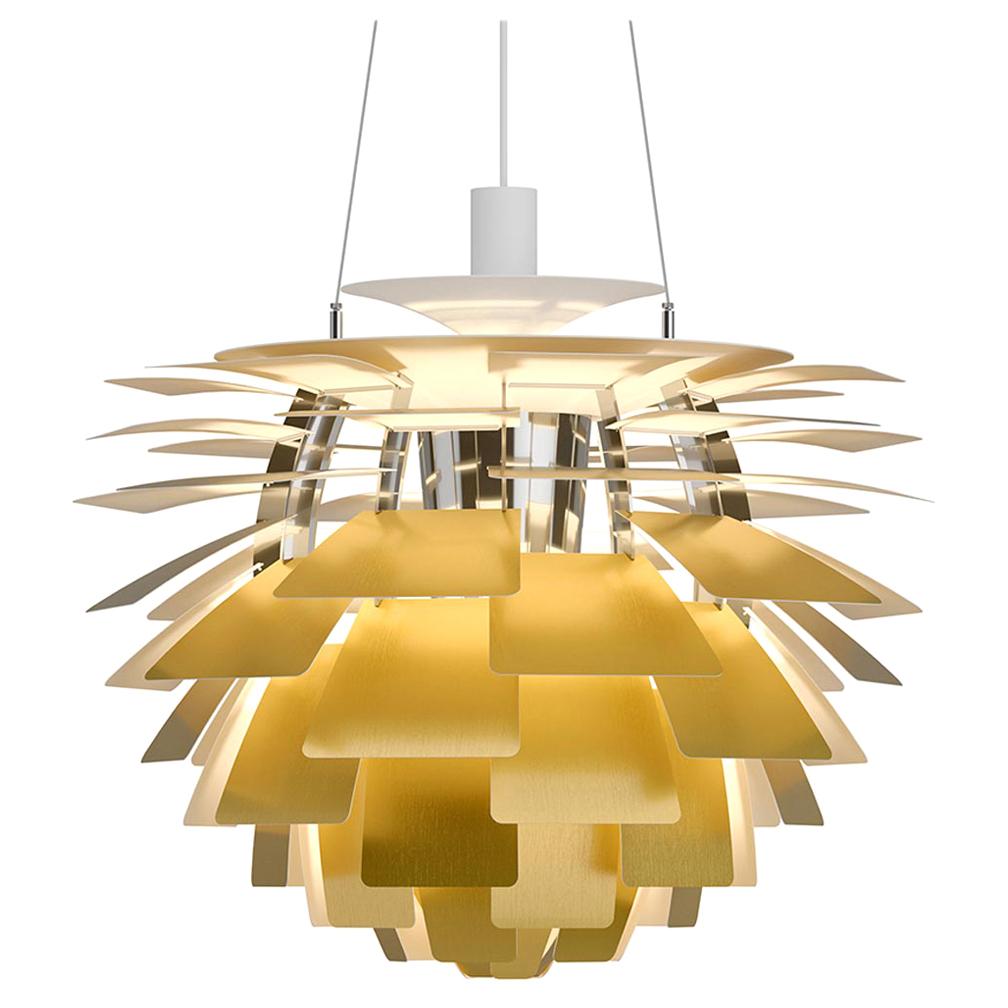Items Similar to Attributed to Poul Henningsen Artichoke, 1957
Video Loading
Want more images or videos?
Request additional images or videos from the seller
1 of 11
Attributed to Poul Henningsen Artichoke, 1957
About the Item
Hanging lamp.
To take care of your property and the lives of our customers, the new wiring has been done.
If you want to live in the golden years, this is the lighting that your project needs.
If you are looking for an chandelier to match the set of sconces we have what you need.
We have specialized in the Art Deco and Art Nouveau and Vintage styles since 1982. If you have any questions we are at your disposal.
Pushing the button that reads 'View All From Seller'. And you can see more objects to the style.
Poul Henningsen (1894-1967), born in Copenhagen, Denmark, is an influential Danish designer, writer and cultural critic. As an indicator designer of the classic Danish lighting brand Louis Poulsen , he devoted his whole life to the exploration and experimentation of lighting, and was praised by the world as the first inventor who combined science and art. Representative works include PH lamp series, PH Artichoke, PH Septima, PH Snowball, etc. His life creation has left an important chapter for modernism, and continues to influence the aesthetic style of Scandinavia until today. In 1967, Paul. Henningsen rests peacefully in Bisbeyo Cemetery, Denmark, and one of the subway stations in Copenhagen is named "Poul Henningsen Plads" in commemoration.
If God created light, then Paul. Henningsen harnesses the light. Perhaps because he has experienced two world wars in his life, he is good at observing all kinds of social conditions from the turbulent times, and seeing clearly the appearance of turmoil and emptiness, so the spirit of creation of works comes from function and converges on simplicity.
Born in Copenhagen, Denmark in 1894, Paul. Henningsen studied at the Technical University of Denmark (Technical University of Denmark) when he was a teenager. After years of technical training, he finally became an independent architect. However, after successfully designing several houses, factories and other examples, he found that he was very interested in lamps and lanterns. On the contrary, he has great enthusiasm for innovation, so he chooses to stop the road of architecture here, and resolutely devotes all his energy to the field of lighting. Back in 1925, Paris was holding the international exhibition "International Exposition of Modern Industrial and Decorative Arts" (International Exposition of Modern Industrial and Decorative Arts). At that time, the Danish lighting brand Louis Poulsen also signed up to participate in the exhibition and hired the then industrial Designer Paul. Henningsen joined the team, and it was this opportunity that allowed him to create a prototype of a lamp with a multi-layer lampshade—the Paris Lamp. This lamp was highly praised at the time and was awarded a gold medal, which established a solid foundation for him to continue to cooperate with the brand
Continuing the simple and generous style of the Paris Lamp, after cooperating with Louis Poulsen, Paul. Henningsen applied the multi-layer lampshade technology to the extreme. The first PH lamp named after his initials was launched in 1927, and developed the design concept of "Three-shade System". The "line" principle accurately calculates the diameter, proportion and downward curvature of the three-layer lampshade, so that the light of each bulb can be reflected into a homogeneous light source when it shines on the surface of the lampshade, and the brightness of the light is gradually weakened through the lampshade, allowing the light to refract downward. Integrating into a mild, uniform and non-glare overall light source, it creates a lighting technology that people cannot see the central light source when looking at each lamp.
In 1958, the classic lamp PH 5 chandelier was exhibited for the first time in the Danish Art Museum. The diameter of this lamp was 50 cm, so it was named PH 5. It uses four main lampshades, plus two small mini lampshades to stack and cover the bulbs. It is designed based on the principle of multi-level equiangular spirals, allowing light to shine on the lampshade at the same incident angle, and then reflected from the bottom of the lamp. Warm light, so that people will not look directly at the light source when viewing, achieving a glare-free lighting technique. Interestingly, Paul. Henningsen believes that "the most beautiful moment of the day is at dusk", so he installed a warm-colored mini lampshade inside the lamp, using optical principles to blend a pleasant soft light, and ensured that the brightness of the light source will not be higher than the evening light, as if the The warm glow of dusk extends into the room through the lights.
Paul. Henningsen designed the PH Artichoke (artichoke chandelier) for the Langelinie Pavilion restaurant in Copenhagen in 1958. Because it looks like a pine cone, it is also often called a pine cone chandelier. This lamp is Paul. Henningsen's classic masterpiece is also one of the most iconic lamps in the design world. The whole lamp is composed of 72 metal blades stacked and staggered. From grinding, painting, shaping, to assembling the 12-layer spherical lamp body, the metal blades are all handmade by professional masters. The installation and deployment make the path of light beam reflection and refraction through precise calculation, the bulb is completely covered by the lamp body, and the light source cannot be seen from any angle, so that the light source is hidden in the gap between the leaves and flows slowly.
PH Septima is recognized as Paul. The most refined of all Henningsen's design chandeliers. The lamp's original design was first published in 1928 at the Danish Museum of Art Installation (now Design museum Denmark), and its poetic appearance received unanimous praise at the time. In 1940, due to the lack of raw materials, production was forced to stop. In 2020, Louis Poulsen optimized the product and improved the tolerance and stability of the glass, allowing the most mature seven-layer glass chandelier in Poul Henningsen's design to come back to the market. PH Septima started with the design of the PH 5/5 three-layer series, and added four more layers. There are a total of seven layers of Septima lampshades, made of extremely fine and detailed Italian borosilicate heat-resistant glass, and each lampshade is made of transparent Interlaced whitewashing with frosted glass blocks, and precise interlacing of transparent and matte blocks between each layer of lampshades, so labor-intensive and time-consuming, the success of the lamps exudes a poetic and elegant atmosphere.
As a master of Nordic lighting, Paul. Henningsen not only designs lamps, but also elegantly develops the plasticity of light. Although the PH series lamps are all based on the "Three-shade System" as the main axis of the concept, you can still understand his projection of each lamp from various types. emotions and details. The times have proved that his design style is "beyond time constraints", and it has become an indicator representative of Scandinavian Style, and it also embodies the perfect example of the combination of science
Why are there so many antiques in Argentina?
In the 1880 – 1940 there was a grate wave of immigration encouraged by the periods of war that were taking place.
1st World War took place between 1914 and 1918
2nd World War took place between 1939 and 1945
The immigrants options were New York or Buenos Aires. Tickets were cheap and in Buenos Aires they were welcomed with open arms, as it was a country where everything was still to be done.
Argentina was the country of new opportunities, labour was needed and religious freedom was assured, in many cases the of the family travel first until they were settled and then the rest of the family members join them.
In the immigrant museum “Ellis Island Immigrant Building” in New York you can se the promotional posters of the boats that would take them to a new life.
Between the years 1895 and 1896, Argentina had the highest DGP (gross domestic product) per capita in the world according to the Maddison Historical Statistics index, this situation arose due to the large amount of food being exported to European countries, which were at war.
The Argentinean ships left the port of Buenos Aires with food, but they returned with furniture, clothes and construction elements, (it´s common to see this the old buildings of the historic neighbourhood of San Telmo, the beams with the inscription “Made in England)”, as well as many markets that were built in Buenos Aires, such us the San Telmo Market, whose structure was brought by ship and afterwards assembled in 900 Defensa Street.
With the great influence of European immigrants living in the country, the children of the upper classes travelled to study in France, resulting in the inauguration of “La Maison Argentinienne”, on 27th of June 1928, in the international city of Paris, which hosted many Argentinians that were studying in Frace.
It´s the fourth house to be built after France, Canada and Belgium, being the first Spanish-speaking one. Still in place today (17 Bd Jourdan, 75014, Paris, France). Many of the children of these wealthy families who attended international art exhibitions, museums and art courses abroad, took a keen interest in the European style. This is why Buenos Aires was at the time referred as “The Paris of South America”.
Between the years 1890 and 1920 more than a hundred Palaces were built on Alvear Avenue the most exclusive avenue in Buenos Aires. Today some of these palaces have been transformed into museums, hotels and embassies.
In the year 1936, the Kavanagh building was inaugurated, it was the tallest reinforced concrete building in South America.
During 1994 the American Society of Civil Engineers distinguished it as an “international engineering milestone”, and it´s now considered a World Heritage of Modern Architecture.
At the time was common to hire foreign architects such as Le Corbusier, who visited Buenos Aires/Argentina in 1929 and in 1948 he drew up the blueprints for a house built in La Plata City (which was declared a World Heritage Site).
In 1947, the Hungarian architect Marcelo Breuer designed “Parador Ariston” in the seaside city of Mar del Plata. After an Argentinean student at Harvard University convinced him to come to Argentina. He worked on an urban development project in the Casa Amarilla, area of La Boca.
The Ukrainian architect, Vladimiro Acosta, arrives in Argentina in 1928 and worked as an architect until que moved to Brazil.
Antonio Bonet, a Spanish architect who worked with Le Corbusier in Paris, arrives in Argentina in 1937, where he carried out several architectural works and in 1938 designs the well-known BFK chair.
Andres Kálnay, of Hungarian origin, made around 120 architectural masterpieces, among which the former Munich brewery stands out, he even made the furniture’s design.
The German architect, Walter Gropius, director of the Bauhaus, lived in Argentina, where he wrote articles for “Sur” magazine and founded in Buenos Aires, an architectural firm with Franz Möller, who was also an architect, where he built two houses.
At the same time several famous designers decided to immigrate to Argentina, among them we can find the well-known French designer, Jean-Michel Frank, who arrived in the country in 1940 and also worked for the Rockefeller family.
Special pieces were made, which were sold exclusively in the country, such as the well-known German company “WMF”, who sold their products by catalogue, which were chosen by the ladies of high society in the list of wedding gifts, as well as the pieces designed by Christofle.
The Swiss sculptor Alberto Giacometti, made special pieces for Argentinean mansions.
In 1904 the first Jansen branch outside Paris was established in Buenos Aires, as the Argentinean clientele demanded a large amount of furniture, from the end of the 19th century to the mid-20th century.
In 1970, the brand Rigolleau Argentina made pieces authorised by Lalique.
The brands Maple and Thompson also set up shop in the country.
The French plastic artist, Marcel Duchamp moved to Argentina in 1918-1919.
Glass signed Gallé, Charder, Leverre, Schneider, Muller and other French firms. They were bought in flower shops and were given to ladies with beautiful floral arrangements.
Some furniture manufacturers travelled to international fairs and bough the patterns to produce the furniture in Argentina, such as the furniture firm Englander and Bonta, who bought the patterns ins Italy.
It is worth mentioning that in Argentina we have the largest community of Italians outside of Italy, as it is estimated that 70 percent of the inhabitants have at least one Italian descendant, followed by Spanish immigrants.
The most Important furniture stores in Argentina:
Comte is founded in 1934 (under the direct management of Jean Michel Frank in 1940).
Nordiska (Swedish company established in 1934).
Churba in 1960, a company that brought foreign designers to present their furniture in the country:
Denmark: (Arne Jacobsen, Finn Juhl, Bender Madsen, Ejner Larsen, Poul Kjaerholm, Hans Wegner)
Sweden: (Hans Agne Jakobsson, Gustavsberg)
United States: (Herman Miller)
Finland: (Lisa Johansson, Folke Arstrom, Tapio Wirkkala, Alvar Aalto, Timo Sarpaneva)
Swedish Factory: (Orrefors)
Italy: (Littala, Vico Magistretti, Emma Gismondi, Gae Aulenti, Angelo Mangiarotti, Elio Martinelli, Gianna Celada, Angelo Mangiarotti, Mario Bellini, Carlo Scarpa)
Finland: (Olivia Toikka)
Plata Lappas (Lappas Silver): a goldsmith shop founded in 1887 in Argentina by Alcibiades Lappas of Greek origin.
In 2019, in Argentina took place “the Art Deco world congress”, in which we participated as hosts invited by Geo Darder, founder of the Copperbridge – Foundation, in which prominent people from all over the world attended to learn about Art Deco in Argentina.
Argentina currently has more than 100 Art Deco buildings and another 90 Art Nouveau buildings throughout the city of Buenos Aires.
Argentina is a country that has not been involved in many wars, which is why it has been a refuge for works of art and antiques from different periods of time, unlike European countries. That is way many collectors, museums and antique dealers from all over the world visit it, you should not miss the opportunity to visit this great country.
Laura Guevara Kjuder, architect.
- Attributed to:Poul Henningsen (Artist)
- Dimensions:Height: 19.69 in (50 cm)Diameter: 23.63 in (60 cm)
- Power Source:Hardwired
- Voltage:220-240v
- Lampshade:Included
- Style:Mid-Century Modern (Of the Period)
- Materials and Techniques:
- Place of Origin:
- Period:
- Date of Manufacture:1957
- Condition:Rewired. Wear consistent with age and use.
- Seller Location:Ciudad Autónoma Buenos Aires, AR
- Reference Number:
About the Seller
5.0
Vetted Seller
These experienced sellers undergo a comprehensive evaluation by our team of in-house experts.
Established in 1982
1stDibs seller since 2022
21 sales on 1stDibs
Typical response time: <1 hour
- ShippingRetrieving quote...Ships From: Ciudad Autónoma Buenos Aires, Argentina
- Return PolicyThis item cannot be returned.
More From This SellerView All
- Unusual Poul Henningsen PH-4/4 Stamped P.H-4 'D.R.P' Deutsche Reichs Patent .By Poul HenningsenLocated in Ciudad Autónoma Buenos Aires, CHanging lamp. Model PH-4/4 Normal treph lamp patent P.H Treph lamp with glass shades Sing P.H-4 (D.R.P) = Deutsche Reichs Patent. glass measures 400mm 260mm 128mm Material: art glass and iron. Style: Art Deco. To take care of your property and the lives of our customers, the new wiring has been done. If you want to live in the golden years, this is the lighting that your project needs. If you are looking for an chandelier to match the set of sconces we have what you need. We have specialized in the sale of Art Deco and Art Nouveau and Vintage styles since 1982.If you have any questions we are at your disposal. Pushing the button that reads 'View All From Seller'. And you can see more objects to the style for sale. Poul Henningsen (1894-1967), born in Copenhagen, Denmark, is an influential Danish designer, writer and cultural critic. As an indicator designer of the classic Danish lighting brand Louis Poulsen , he devoted his whole life to the exploration and experimentation of lighting, and was praised by the world as the first inventor who combined science and art. Representative works include PH lamp series, PH Artichoke, PH Septima...Category
Vintage 1920s Danish Art Deco Chandeliers and Pendants
MaterialsIron
- Chandelier Arts and Crafts Attributed to Charles Rennie Mackintosh, 1883By Charles Rennie MackintoshLocated in Ciudad Autónoma Buenos Aires, CAmaizing chandelier. Country: Scotland Material: silver plated bronze and glass year: 1883 If you are looking for sconces to match your ceiling lighting, we have what you need. It is an elegant and sophisticated chandelier. You want to live in the golden years, this is the chandelier that your project needs. We have specialized in diferent styles since 1982.If you have any questions we are at your disposal. Pushing the button that reads 'View All From Seller'. And you can see more objects to the style for sale. Charles Rennie Mackintosh (7 June 1868 – 10 December 1928) was a Scottish architect, designer, water colourist and artist. His artistic approach had much in common with European Symbolism. His work, alongside that of his wife Margaret Macdonald, was influential on European design movements such as Art Nouveau and Secessionism and praised by great modernists such as Josef Hoffmann. Mackintosh was born in Glasgow and died in London. Charles Rennie Mackintosh was born at 70 Parson Street, Townhead, Glasgow, on 7 June 1868, the fourth of eleven children and second son of William McIntosh...Category
Antique 1880s Scottish Arts and Crafts Chandeliers and Pendants
MaterialsBronze
- Chandelier in Murano Attributed to Venini Style, Art Deco, 1920By VeniniLocated in Ciudad Autónoma Buenos Aires, CHanging lamp Material: Murano Style: Art Deco Country: Italian If you want to live in the golden years, this is the lighting that your project needs. We have specialized in the sal...Category
Vintage 1920s Italian Art Deco Chandeliers and Pendants
MaterialsMurano Glass
- Monumental Chandelier Art Nouveau Glass Daum Nancy attributed to Louis majorelleLocated in Ciudad Autónoma Buenos Aires, CAmazing hanging lamps in bronze Style: Art Nouveau and Modernism or Jugendstil Year: 1915 Material: bronze, If you are looking for sconces to match your ceiling lighting, we have w...Category
Vintage 1910s French Art Nouveau Chandeliers and Pendants
MaterialsBronze
- Chandelier in Opaline and Iron, 1930, German attributed to Peter BehrensLocated in Ciudad Autónoma Buenos Aires, CYear: 1935. Material: opaline and iron. For your safety and that of your property, all our lighting have new electric cables. We always think of our customers. If you have any questions we are at your disposal. We have specialized in the sale of Art Deco and Art Nouveau styles since 1982. If you are looking for sconces to match your ceiling lighting, we have what you need. Pushing the button that reads 'View All From Seller'. And you can see more objects to the style for sale. Peter Behrens, (14 April 1868 – 27 February 1940) was a leading German architect, graphic and industrial designer, best known for his early pioneering AEG Turbine Hall in Berlin in 1909. He had a long career, designing objects, typefaces, and important buildings in a range of styles from the 1900s to the 1930s. He was a foundation member of the German Werkbund in 1907, when he also began designing for AEG, pioneered corporate design,graphic design, producing typefaces, objects, and buildings for the company. In the next few years, he became a successful architect, a leader of the rationalist / classical German...Category
Vintage 1930s German Bauhaus Chandeliers and Pendants
MaterialsIron
- Art Deco Chandelier in Opaline and Chrome, German Attributed to Peter BehrensBy Peter BehrensLocated in Ciudad Autónoma Buenos Aires, CStyle: Art Deco. Year: 1920. Material: opaline and chrome For your safety and that of your property, all our lighting have new electric cables. We always think of our customers. We have specialized in the sale of Art Deco and Art Nouveau and Vintage styles since 1982. If you have any questions we are at your disposal. Pushing the button that reads 'View All From Seller'. And you can see more objects to the style for sale. Peter Behrens, (14 April 1868 – 27 February 1940) was a leading German architect, graphic and industrial designer, best known for his early pioneering AEG Turbine Hall in Berlin in 1909. He had a long career, designing objects, typefaces, and important buildings in a range of styles from the 1900s to the 1930s. He was a foundation member of the German Werkbund in 1907, when he also began designing for AEG, pioneered corporate design, graphic design, producing typefaces, objects, and buildings for the company. In the next few years, he became a successful architect, a leader of the rationalist / classical German...Category
Vintage 1920s German Bauhaus Chandeliers and Pendants
MaterialsChrome
You May Also Like
- Poul Henningsen Artichoke Pendant LightBy Poul HenningsenLocated in Los Angeles, CAPoul Henningsen for Louis Poulsen Artichoke pendant light, Denmark, circa 1957. Copper, aluminum, and enameled steel.Category
Mid-20th Century Danish Mid-Century Modern Chandeliers and Pendants
MaterialsMetal, Copper
- Poul Henningsen Ph Artichoke Pendant, X-LargeBy Louis Poulsen, Poul HenningsenLocated in Berkeley, CAThe fixture provides 100% glare-free light. The 72 precisely positioned leaves form 12 unique rows of six leaves each. They illuminate the fixture as well as emitting diffused light with a unique pattern. The fixture provides decorative and comfortable lighting. For the energy saving LED variant the quality of light and atmosphere surrounding the product is kept at the highest level. The PH Artichoke...Category
21st Century and Contemporary American Mid-Century Modern Chandeliers an...
MaterialsChrome
- Poul Henningsen Ph Artichoke Pendant, MediumBy Louis Poulsen, Poul HenningsenLocated in Berkeley, CAThe fixture provides 100% glare-free light. The 72 precisely positioned leaves form 12 unique rows of six leaves each. They illuminate the fixture as well as emitting diffused light with a unique pattern. The fixture provides decorative and comfortable lighting. For the energy saving LED variant the quality of light and atmosphere surrounding the product is kept at the highest level. The PH Artichoke...Category
21st Century and Contemporary American Mid-Century Modern Chandeliers an...
MaterialsChrome
- Poul Henningsen Ph Artichoke Pendant – LargeBy Louis Poulsen, Poul HenningsenLocated in Berkeley, CAThe fixture provides 100% glare-free light. The 72 precisely positioned leaves form 12 unique rows of six leaves each. They illuminate the fixture as well as emitting diffused light with a unique pattern. The fixture provides decorative and comfortable lighting. For the energy saving LED variant the quality of light and atmosphere surrounding the product is kept at the highest level. The PH Artichoke...Category
21st Century and Contemporary American Mid-Century Modern Chandeliers an...
MaterialsChrome
- Poul Henningsen Ph Artichoke Pendant – SmallBy Louis Poulsen, Poul HenningsenLocated in Berkeley, CAThe fixture provides 100% glare-free light. The 72 precisely positioned leaves form 12 unique rows of six leaves each. They illuminate the fixture as well as emitting diffused light with a unique pattern. The fixture provides decorative and comfortable lighting. For the energy saving LED variant the quality of light and atmosphere surrounding the product is kept at the highest level. The PH Artichoke...Category
21st Century and Contemporary American Mid-Century Modern Chandeliers an...
MaterialsChrome
- Large Artichoke Lamp by Poul HenningsenBy Louis Poulsen, Poul Henningsen, Poul Hermann PoulsenLocated in Brooklyn, NYMonumental pendant lamp by Poul Henningsen for Louis Poulsen. Suspended by ivory enameled-steel canopy, the interior chrome cylinder is surrounded by layers of brushed copper leaves....Category
Vintage 1960s Danish Mid-Century Modern Chandeliers and Pendants
MaterialsCopper, Chrome
Recently Viewed
View AllMore Ways To Browse
Ship To Italy
Poul Poul
Poster Denmark
Danish Modern La
Danish Boat
Danish Country Antiques
Antique Danish Country Furniture
Danish Antique Country Furniture
Poul Kjaerholm Set
European Mid Century Port
Danish Palace
Danish Flower Still Life
Poul Kjaerholm Style
Mid Century Brazil Antiques
Two Modern Gropius
Denmark Travel Poster
Travel Poster Denmark
Flower Stand Danish
